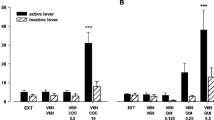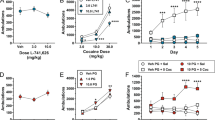Abstract
Recent evidence suggests that the dopamine D4 receptor may play a role in schizophrenia, and that the atypical properties of the antipsychotic clozapine may be attributable in part to its antagonistic actions at this receptor. In the present study, clozapine and three other compounds having D4 dopamine receptor antagonist properties were examined for their effectiveness in reducing losses in prepulse inhibition (PPI) induced in rats by the dopamine receptor agonist apomorphine. Previously, activity in the PPI model has been shown to correlate highly with the antipsychotic potency of a number of neuroleptics. As previously reported, clozapine (1–5.6 mg/kg) significantly reduced apomorphine-induced PPI deficits. The three D4-selective compounds, CP-293,019 (5.6–17.8 mg/kg), U-101,387 (3–30 mg/kg) and L-745,870 (1–10 mg/kg), also significantly blocked the losses in PPI produced by apomorphine. Taken together, these results suggest that dopamine receptor antagonists with selectivity for the D4 dopamine receptor subtype may be effective in the treatment of schizophrenia, while being less likely to produce dyskinesias associated with D2 receptor antagonists.
Similar content being viewed by others
Author information
Authors and Affiliations
Additional information
Received: 13 May 1997/Final version: 15 July 1997
Rights and permissions
About this article
Cite this article
Mansbach, R., Brooks, E., Sanner, M. et al. Selective dopamine D4 receptor antagonists reverse apomorphine-induced blockade of prepulse inhibition. Psychopharmacology 135, 194–200 (1998). https://doi.org/10.1007/s002130050501
Issue Date:
DOI: https://doi.org/10.1007/s002130050501




